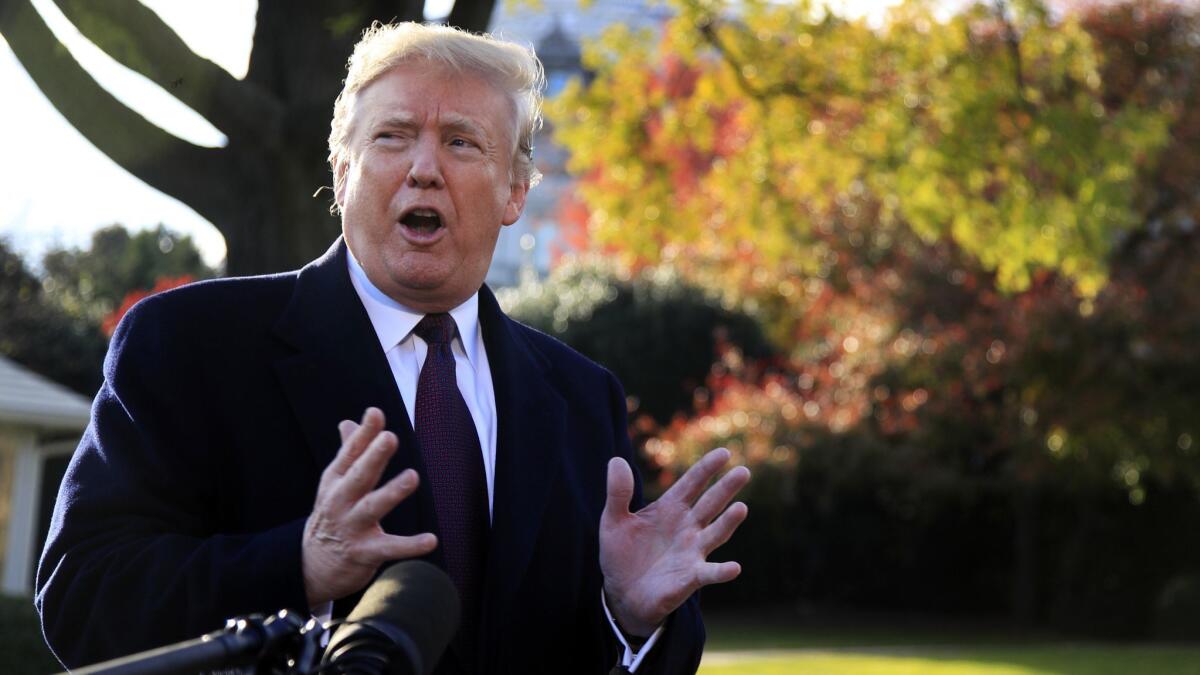Trump lashes out after judge rules that migrants who cross border illegally can seek asylum

Reporting from Washington — The Trump administration must once again process asylum claims from migrants apprehended at the U.S.-Mexico border, a bitter blow for a president who has waged an all-out effort — including the deployment of thousands of military troops — to stanch the flow of Central American families into the country.
President Trump lashed out Tuesday at the federal judge in San Francisco who halted his hard-line asylum policy, saying he would file “a major complaint.”
“This was an Obama judge and I’ll tell you what, it’s not going to happen like this anymore,” Trump said. “We will win that case in the Supreme Court of the United States.”
As several migrant caravans trudged through Mexico toward the United States earlier this month, Trump tried to bar migrants who cross the border illegally from seeking asylum, saying they could qualify only if they waited in line at a legal checkpoint.
The president had troops unfurl miles of razor wire at border hot spots and pelted migrants with tweets, calling them “thugs” and ordering them on Sunday to “Go home!”
But U.S. District Judge Jon Tigar ruled late Monday that federal law clearly states that migrants can seek asylum anywhere on U.S. soil. Tigar said the president’s new rules exposed adults and children to “increased risk of violence and other harms.”
“Whatever the scope of the President’s authority, he may not rewrite the immigration laws to impose a condition that Congress has expressly forbidden,” the judge, appointed by President Obama, wrote in his 37-page ruling.
RELATED: Judge bars U.S. from enforcing Trump asylum ban at Mexican border »
The Trump administration expressed confidence the asylum policy will ultimately prevail in court, in part because it relies on the same presidential authority Trump asserted in a modified travel ban — barring specific travelers mainly from majority-Muslim nations — that the Supreme Court narrowly upheld in June.
Department of Homeland Security Secretary Kirstjen Nielsen, who has drawn Trump’s wrath as the number of families caught crossing the border each month continues to grow, said she was “deeply disappointed” in Tigar’s ruling and predicted it will “undoubtedly be overturned.”
The decision was the latest in a string of court defeats for a president who has pledged to crack down on illegal immigration. Federal judges have temporarily blocked Trump’s efforts to strip funding from “sanctuary” cities and rescind temporary work permits and deportation protections from roughly 1 million immigrants who were protected under past administrations. Both those rulings are being challenged by the government. The president’s “zero tolerance” policy, which forcibly separated parents and children at the border this spring, exploded into a public crisis. And the Republican-led Congress so far has declined to fund his promised border wall.
Four immigrant advocacy groups — the East Bay Sanctuary Covenant, Al Otro Lado, Innovation Law Lab and the Central American Resource Center of Los Angeles — filed suit over the asylum policy hours after the administration issued the new rule in early November.
American Civil Liberties Union attorney Lee Gelernt, who argued the groups’ case before Tigar at a hearing Monday, said the judge’s ruling means that migrants can apply for asylum anywhere along the nearly 2,000-mile Mexican border, as they have done for decades. But he said the decision to cross illegally is theirs alone.
“We don’t, and would not, advise anybody to break the law,” he said. But he added that advocates believe many will attempt to sneak across the border because the U.S. government is limiting the number of asylum seekers who can cross at legal ports of entry.
“The wait is so long, and it’s dangerous,” Gelernt said. “Out of necessity, historically, people have done what they need to do to save their lives .... That’s why Congress has this provision in the statute and has never changed it.”
RELATED: Chief justice criticizes Trump for ‘Obama judge’ asylum comment »
Tigar’s temporary restraining order against Trump’s policy is in place until Dec. 19, when he will hear arguments on whether to issue a permanent injunction prohibiting it.
Advocates say migrant families are fleeing gang violence and poverty in some of the world’s most dangerous nations, while the Trump administration says they are filing false asylum claims to win release so they can work in the United States, which is not a legitimate reason to seek refuge.
Because there are a fixed number of family detention beds and legal limits on how long the government can detain children, most migrant families are released.
Migrants waiting at the border in Mexico on Tuesday struggled to chart their next steps. Many said they were unaware of Tigar’s ruling, and some were still unwilling to make the journey illegally.
Others said they were growing increasingly impatient and frustrated in dusty, makeshift shelters in a crowded sports complex in Tijuana, where the bulk of the migrant caravan is staying.
“Yesterday we tried to go get on the list for asylum, but there was no one there,” said Pablo Rio, a 45-year-old Nicaraguan. He said he fled his country after gun-wielding paramilitaries threatened him at his house in the city of Leon for protesting against President Daniel Ortega.
“We want to go legally, but we also can’t wait anymore,” he said. “I can’t go back to my country.”
Quenedi Valladares, 53, from Olancho, Honduras, said he went to the border Monday to put his name on an asylum list.
“They said it would be a long time before it would be my turn — months. I don’t really know what to do,” Valladares said. “I just want to get to my family in Virginia .... It’s pretty rough in here, and I’m getting tired. But I want to go legally.”
Erika Pinheiro, a lawyer with Al Otro Lado, one of the plaintiffs in the asylum-ban lawsuit, is helping coordinate legal services in Tijuana. At the border, she holds meetings with migrants to explain their rights and discuss how to proceed.
As Pinheiro thumbed through her PowerPoint presentation Tuesday, she crossed off the bullet point under the asylum-process section that said, “Enter the United States legally.”
“I’ve spent so long updating this over the past few months,” she said. “People are just desperate for information.”
The Mexican government says it is aiding more than 5,600 migrants from Honduras, El Salvador and Guatemala on the U.S. border — 2,610 in Tijuana and 2,995 in Mexicali.
Military spokesman Michael Kucharek said Tuesday that U.S. troops will continue to assist Customs and Border Protection in a support role, providing helicopters, medical assistance and logistics help that includes installing barbed wire and other barriers along the border. As of this week, about 5,800 U.S. military members were still deployed to the border — 2,800 in Texas, 1,500 in California and 1,500 in Arizona.
Col. Rob Manning, a Defense Department spokesman, said the estimated total cost of the troop deployment through Dec. 15 is $72 million, in addition more than $400 million in planned spending for National Guard border deployments from April of this year to September 2019.
Border apprehensions are down significantly from the 1990s and 2000s, but family migration has increased sharply, frustrating the Trump administration because parents and children are difficult to detain and deport.
White House Press Secretary Sarah Huckabee Sanders called Tigar’s ruling “yet another example of activist judges imposing their open borders policy preferences.”
“This decision will open the floodgates, inviting countless illegal aliens to pour into our country on the American taxpayer’s dime,” she said in a statement. “We will take all necessary action to defend the executive branch’s lawful response to the crisis at our southern border.”
Sacchetti and Kinosian write for the Washington Post.
More to Read
Sign up for Essential California
The most important California stories and recommendations in your inbox every morning.
You may occasionally receive promotional content from the Los Angeles Times.










